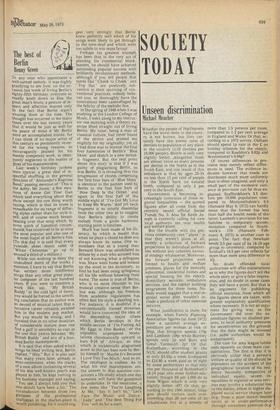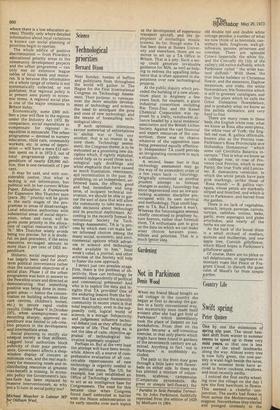SOCIETY TODAY
Unseen discrimination
Michael Meacher
Whether the people of Hartlepools have the worst teeth in the country is not known, but they certainly have the lowest ratio Of dentists to population of any place in the country (1.03 dentists per 10,000 people). Bootle is only very slightly better, .Altogether there are almost twice as many persons per dentist in the North as in the South-East, and one result of this imbalance is that by Ages 25-34 no less than 15 per cent of people in the North have no natural 'teeth, compared to only 2 per cent in the South -East. •
Government is becoming increasingly conscious of these regional inequalities — the quoted figures after all come from the recently issued official Social Trends No. 3. Also Sir Keith Joseph is currently calling for new local authority ten year health and welfare plans.
But the trouble with the previous community care "plans " is that they weren't plans at all, merely a collection of forward projections by individual authorities without any coherent national strategy whatsoever. Moreover, the forward projections were limited to health and welfare premises, places for the mentally subnormal, residential homes and special housing for the elderly, domiciliary services, ambulance services, and the capital building programme for these items. Nobody would suggest that a real regional social plan wouldn't include a plethora of other essential services.
What justification is there, for; example, when Family Planning • Association figures (at June 1972) show a national average expenditure per woman at risk of 300, that Islington spends 179p and Lambeth 148p while Burnley spends only lp and Bury and Great Yarmouth 2p? Or that Rotherham, according to the NUS, should offer student grants at only £4.33p a week (compared to .£14.80 a week paid as of right by some authorities) so that only one per thousand of Rotherham's 18-19 year olds enter further education, though 89 per 1,000 do so from Wigan which is only very slightly better off? Or that, according to the 1966 census, Glasgow should contain such overcrowding that 20 per cent of its inhabitants live at a density of more than 1.5 persons per room, compared to 1-2 per cent average in England and Wales. Or that, according to a 1972 survey, Oldham should spend lp rate in the £ on holiday schemes for the elderly, compared to Basildon's 0.02p ind Westminster's 0.04p?
Of course differences in provision may merely reflect differences in need. The evidence indicates however that needs are distributed much more uniformly than is often imagined, and only a small part of the excessive variance in provision can be thus explained. Staffordshire's 3.3 doctors per 10,000 population compared to Merionethshire's 6.9 (Hansard May 8, 1972) can hardly mean that the former has less than half the health needs of the' latter. Lambeth's provision for ten families in temporary accommodation compared to Southwark's 179 (Hansard February 8, 1973) is another case in point. The fact that . Newham sends 2.5 per cent of its 18-19 age group to university, compared to
Solihull's 18.5 per cent reflects far I more than mere area difference in IQ.
No doubt offended local authorities will offer explanations as to why the figures don't tell the whole story or give a false impression, and no doubt in some cases they will have a point. But that is an argument for publishing official statistics, from which all the figures above are taken, with greater explanatory qualification where necessary. It is not an argument for giving way, as the Government did over the expenditure figures on disabled persons, to local authority pressures for secretiveness on the grounds that the data might be misused (i.e. some authorities would be embarrassed).
The case for area league tables rests squarely on three main considerations. The first is that it is obviously unfair that a person's welfare or quality of life should be dependent on the accident of the geographical location of his residence. Secondly, irrespective of individual equity, severe Inequalities in regional or area services may involve a substantial loss to the nation, either in higher displaced social service charges later (e.g. from a poor doctor/dentist ratio) or in under-performance through unrealised potential (e.g.
where there is a low education access). Thirdly, only where detailed
information about local variations is known can social planning of priorities begin to operate.
The whole edifice of positive discrimination — from Plowden's educational priority areas to the community development projects and the urban programme — can only rest on extensive league tables of local needs and resources. It is because this information , on a whole range of criteria is not systematically collected, or not published, that regional policy is at present seen purely in economic terms. A regional social plan is one of the major omissions in Britain today.
Economically, some £300 million a year will flow to the regions under the Industry Act 1972. By comparison, social expenditure to compensate for regional in. equalities is minuscule. The urban programme — devoted to nursery education, child care, community , workers, etc. in areas of deprivation — will have a mere £12 million spent on it in 1972-3, out of total programmed public expenditure of nearly £26,000 million, that is one-twentieth of 1 per cent.
It may be said, and with considerable justice, that what is ' lacking is not information, but political will. In her current White Paper, Education: A Framework for Expansion Mrs Thatcher says (para. 28): "priority will be given in the early stages of the programme to areas of disadvantage. Local education authorities with substantial areas of social deprivation, urban and rural, will be given some priority in the allocation of capital resources in 19741' 76." Mrs Thatcher wisely avoids being too precise: for it is doubtful, on past precedent, if the extra resources envisaged amount to more than 1 per cent of DES expenditure.
Hitherto, social regional policy has largely been used for shortterm political convenience rather than the sustained objectives of a social plan. Phase 1 of the urban programme was born in answer to the Powellite scare and directed at demonstrating that something
, positive was being done in immigrant areas — hence the concentration on building schemes (day care centres, children's homes, etc.) to secure rapid visible results. Under Phase V in October 1971, when unemployment was , mounting sharply, approved expenditure was limited to job-crea, tion projects in the development and intermediate areas.
Social planning to rectify our unequal society is thus stillborn. Laggard local authorities block publicity of their poor performance, Government affects a shopwindow display of concern at minimum cost, and the real machinery for measuring needs and redistributing resources at greatest cost-benefit is missing. In economic policy the Government's laissez-faire has been replaced by ,massive interventionism, so why not a U-turn in social policy too?



































 Previous page
Previous page